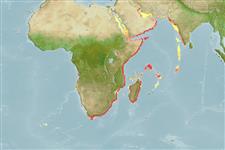>
Eupercaria/misc (Various families in series Eupercaria) >
Haemulidae (Grunts) > Haemulinae
Etymology: Pomadasys: Greek, poma, -atos = cover, operculum + Greek, dasys = with hair (Ref. 45335).
Eponymy: Dr Philibert Commerson (1727–1773) was known as ‘doctor, botanist and naturalist of the King’. [...] (Ref. 128868), visit book page.
More on author: Lacepède.
Environment: milieu / climate zone / depth range / distribution range
Ökologie
seewasser; brackwasser riff-verbunden; ozeanodrom (Ref. 51243); tiefenbereich 0 - 49 m (Ref. 122701). Tropical; 31°N - 37°S, 18°E - 77°E
Southeast Atlantic and Western Indian Ocean: Western and Eastern Cape, South Africa, East Africa, Persian Gulf, Socotra, Seychelles, Madagascar to northwest coast of India.
Length at first maturity / Size / Gewicht / Alter
Maturity: Lm 38.0 range ? - ? cm
Max length : 80.0 cm TL Männchen/unbestimmt; (Ref. 2799)
Rückenflossenstacheln (insgesamt) : 10 - 11; Rückenflossenweichstrahlen (insgesamt) : 14 - 15; Afterflossenstacheln: 3; Afterflossenweichstrahlen: 9 - 10. Juveniles without spots on body (Ref. 2799).
Found in coastal waters, estuaries, and tidal fissures; can tolerate freshwater. It can jet a stream of water into the mud to expose crustaceans, worms and small bivalves which it feeds on (Ref. 11441); including fish (Ref. 5213). Tasty food fish (Ref. 2799). Maximum depth range from Ref. 122702.
Oviparous, distinct pairing during breeding (Ref. 205).
Smith, M.M. and R.J. McKay, 1986. Haemulidae. p. 564-571. In M.M. Smith and P.C. Heemstra (eds.) Smiths' sea fishes. Springer-Verlag, Berlin. (Ref. 2799)
IUCN Rote Liste Status (Ref. 130435: Version 2024-1)
Bedrohung für Menschen
Harmless
Nutzung durch Menschen
Fischereien: kommerziell; Sportfisch: ja
Tools
Zusatzinformationen
Download XML
Internet Quellen
Estimates based on models
Preferred temperature (Ref.
123201): 22 - 27.9, mean 26.8 °C (based on 146 cells).
Phylogenetic diversity index (Ref.
82804): PD
50 = 0.5000 [Uniqueness, from 0.5 = low to 2.0 = high].
Bayesian length-weight: a=0.01905 (0.01223 - 0.02969), b=2.95 (2.82 - 3.08), in cm total length, based on LWR estimates for this species & Genus-body shape (Ref.
93245).
Trophic level (Ref.
69278): 3.5 ±0.2 se; based on diet studies.
Generation time: 5.8 ( na - na) years. Estimated as median ln(3)/K based on 2
growth studies.
Widerstandsfähigkeit (Ref.
120179): niedrig, Verdopplung der Population dauert 4,5 - 14 Jahre. (K=0.07-0.42).
Fishing Vulnerability (Ref.
59153): Low to moderate vulnerability (34 of 100).
Nutrients (Ref.
124155): Calcium = 31 [11, 60] mg/100g; Iron = 0.547 [0.284, 0.949] mg/100g; Protein = 19.9 [18.0, 21.6] %; Omega3 = 0.135 [0.076, 0.229] g/100g; Selenium = 37.4 [22.7, 67.5] μg/100g; VitaminA = 39.3 [14.1, 108.1] μg/100g; Zinc = 1.06 [0.74, 1.61] mg/100g (wet weight);
